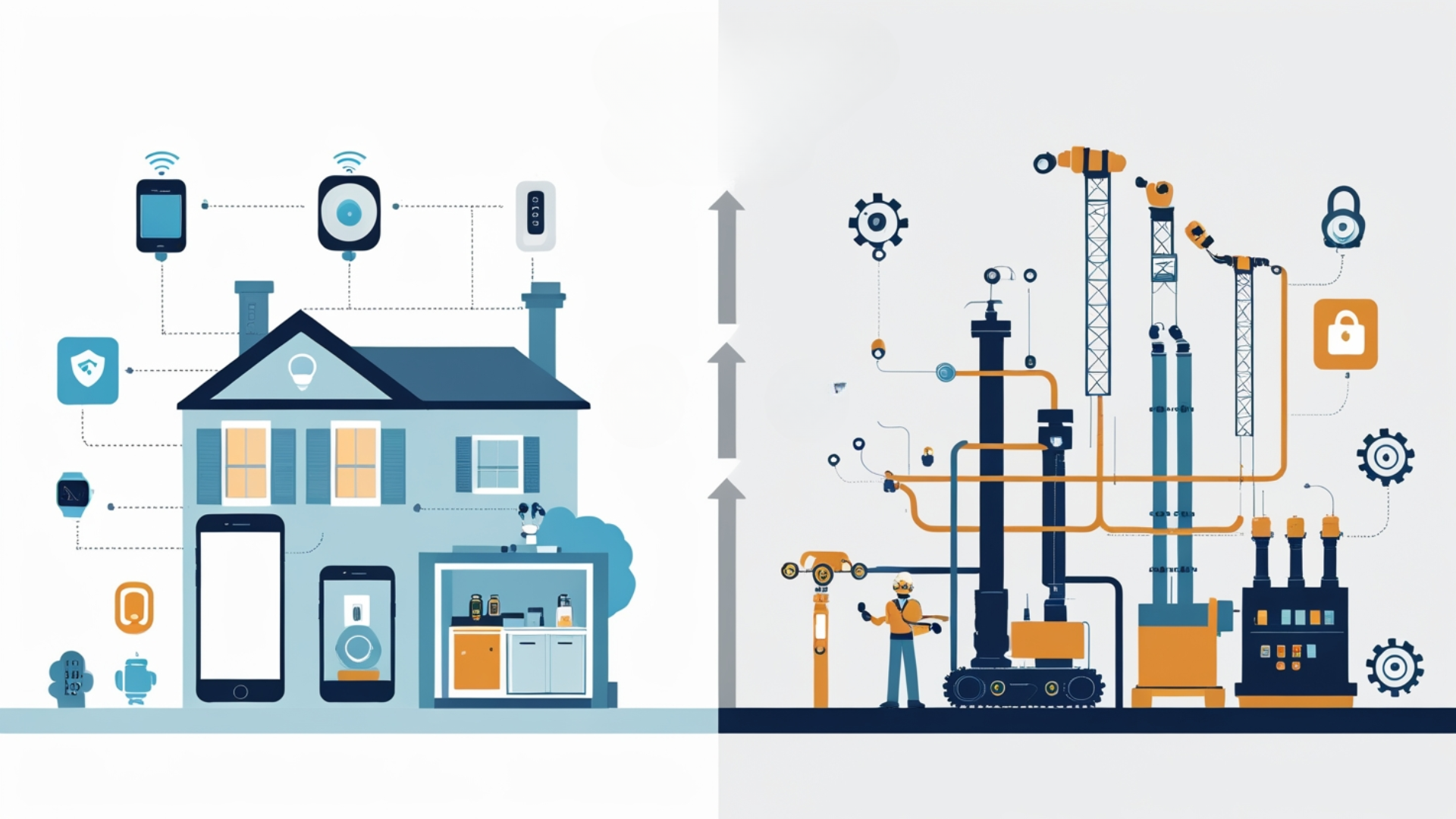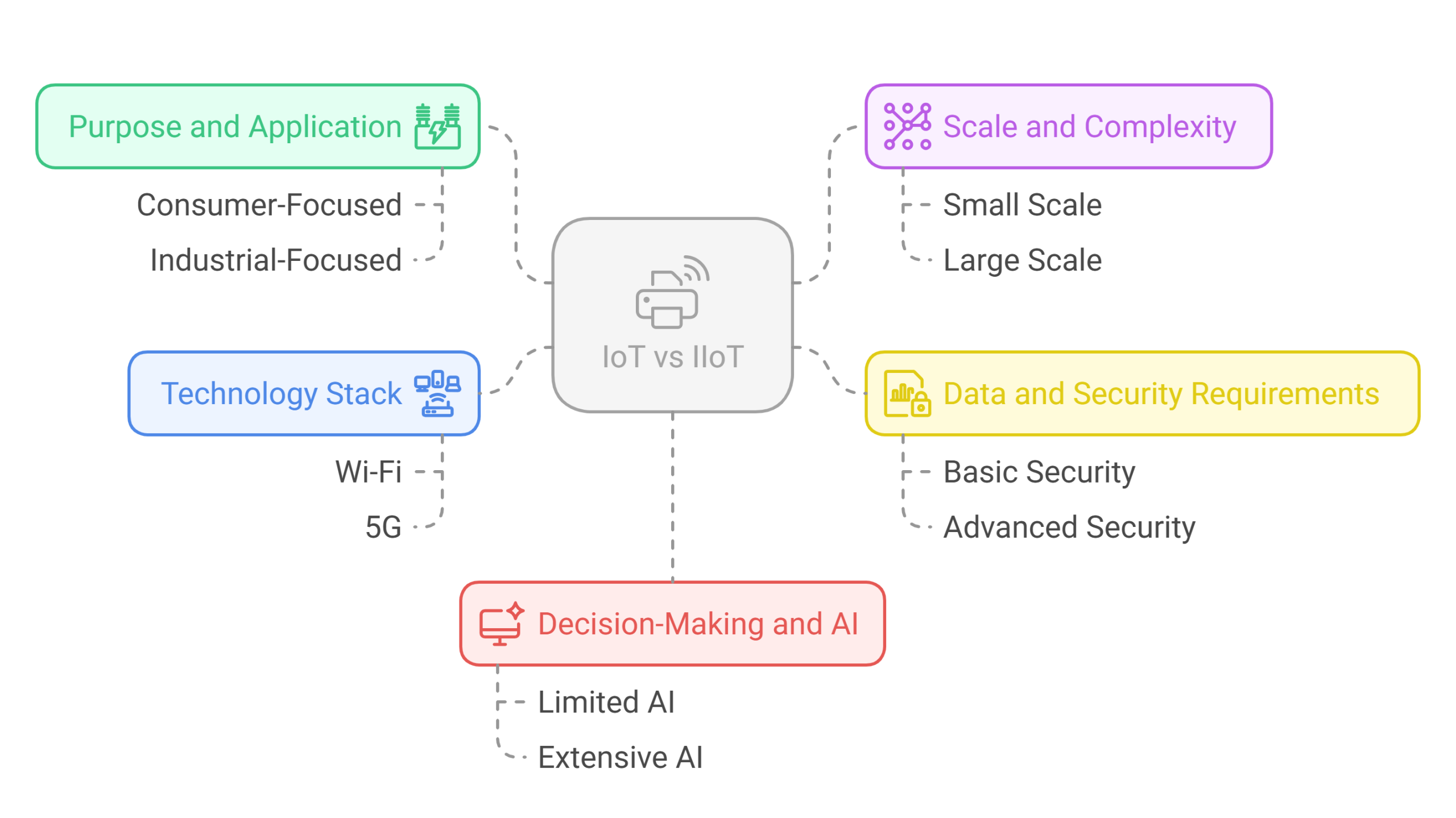
In the fast-evolving digital landscape of 2025, understanding the differences between the Internet of Things (IoT) and the Industrial Internet of Things (IIoT) is more important than ever. Although the two acronyms may appear similar, their functions, target audiences, and real-world impacts vary significantly. As a result, businesses and consumers must recognize their unique characteristics, especially if they hope to harness the full potential of connected technologies.
What is IoT?
IoT refers to the vast network of physical devices—ranging from household gadgets to wearable tech—that connect to the internet to collect and exchange data. Because of IoT, everyday tasks such as adjusting your home thermostat, tracking your fitness, or monitoring your refrigerator’s inventory have all become far more convenient.
For instance, imagine waking up in a smart home where your alarm clock communicates with your coffee maker. Consequently, as soon as you wake up, your coffee begins to brew. Furthermore, if your fridge senses you are low on milk, it can notify your phone or automatically add it to a shopping list. Therefore, IoT’s main goal is clear: to improve quality of life through automation, personalization, and efficiency.
What is IIoT?
On the other hand, the Industrial Internet of Things (IIoT) applies similar principles to a much larger, more complex environment—namely, industry. Here, IIoT connects machinery, sensors, software, and people across factories, refineries, power plants, hospitals, and supply chains. While IoT enhances everyday convenience, IIoT prioritizes productivity, safety, and operational excellence.
For example, a manufacturing facility can install sensors on machinery to monitor vibrations, temperature, and energy consumption. If a sensor detects an anomaly, engineers receive alerts in real time, allowing them to intervene before a breakdown occurs. Moreover, such predictive maintenance saves substantial costs, reduces downtime, and increases safety for workers. Thus, IIoT is critical for organizations that depend on uninterrupted operations and data-driven decisions.
Key Differences: IoT vs IIoT

1. Purpose and Application
First, it is essential to understand that IoT is consumer-focused, while IIoT serves industrial sectors. In other words, IoT aims to make daily life more convenient, yet IIoT exists to optimize large-scale businesses and infrastructures. Notably, the stakes in IIoT are much higher, as a malfunction could halt production or jeopardize worker safety.
2. Scale and Complexity
Not only does IIoT operate on a larger scale, but it also deals with more complex systems. While you might have a few connected gadgets at home, IIoT environments feature thousands (if not millions) of interconnected devices, all sharing mission-critical data at high speeds. As a result, industrial settings require robust, fail-safe systems capable of withstanding harsh conditions.
3. Data and Security Requirements
In addition, security expectations for IIoT are much more stringent. While losing connection to your smart doorbell is bothersome, a cyberattack on an IIoT system could disrupt power to a city or cause unsafe manufacturing plant conditions. Accordingly, IIoT networks deploy advanced encryption, authentication, and compliance protocols to guard against threats.
4. Technology Stack
It is also important to recognize differences in technology stacks. IoT typically uses Wi-Fi, Bluetooth, or Zigbee for connectivity, which are suitable for short-range communication. Conversely, IIoT integrates advanced networks such as 5G, edge computing, and private LTE to support large-scale, low-latency, and real-time operations.
5. Decision-Making and AI
Furthermore, IIoT systems often leverage artificial intelligence and machine learning at the edge. Unlike in consumer IoT, industrial environments rely heavily on automated, near-instantaneous decision-making. For example, if a robotic arm in a factory detects an anomaly, the system can pause production and reroute tasks seamlessly, minimizing risk and waste.
Why This Difference Matters in 2025
Now more than ever, enterprises and consumers must distinguish between IoT and IIoT to invest wisely and mitigate risk. Businesses that adopt IIoT can unlock massive benefits:
- Predictive Maintenance: By monitoring equipment in real time, companies can anticipate failures long before they occur, resulting in fewer costly repairs and less unexpected downtime.
- Energy Management: IIoT solutions help organizations analyze consumption, identify inefficiencies, and regulate usage, thus lowering utility bills and carbon footprints.
- Enhanced Safety: With ongoing data analysis, IIoT platforms can detect emerging hazards and notify teams instantly, leading to safer working environments.
Meanwhile, consumer adoption of IoT continues to accelerate. People enjoy personalized comfort—from smart thermostats adjusting room temperature automatically, to fitness apps delivering real-time health insights. Consequently, daily routines have become more automated and enjoyable.
For the workforce, both technologies create exciting opportunities. There is increasing demand for specialists in fields like cybersecurity, data analysis, industrial automation, and AI engineering. Ultimately, this digital transformation promises to reshape the global job market for years to come.
Case Example: How IIoT Transformed a Factory
Consider a mid-sized automotive parts factory facing frequent machine breakdowns. Previously, unplanned downtime cost the company thousands of dollars per hour. After deploying IIoT sensors to monitor vibration and temperature, the maintenance team started receiving predictive alerts.
Within six months:
- Unplanned downtime fell by 45%.
- Overall equipment effectiveness (OEE) jumped by 20%.
- Maintenance costs dropped significantly, as repairs were scheduled proactively.
Because of IIoT, the company became more competitive, ecological, and profitable. This real-life example demonstrates that IIoT is not just theory—it’s a catalyst for meaningful business outcomes.
Conclusion: Taking Action on IoT vs IIoT
In summary, while IoT and IIoT share foundational technologies, their objectives, risks, and rewards differ greatly. For consumers, IoT means smarter, more convenient lives. For industries, IIoT is the backbone of digital transformation—delivering cost savings, safety, and operational agility.
As you plan your digital strategy for 2025 and beyond:
- Carefully assess whether you need IoT, IIoT, or both.
- Consider security, scalability, and real-time requirements.
- Stay informed about emerging standards and best practices.
By making thoughtful investments and keeping up with technological advances, you’ll ensure you are well-positioned—whether at home, at work, or in the wider world—to reap the maximum benefits of a connected future.
FAQs
How do IoT and IIoT communicate?
IoT devices usually communicate over consumer networks like Wi-Fi and the cloud. In contrast, IIoT uses more robust and secure channels such as 5G, edge networks, and dedicated industrial systems to ensure reliable data transfer—even in harsh or remote environments.
Why is cybersecurity a bigger issue for IIoT?
Since IIoT systems control critical infrastructure and sensitive data, successful cyberattacks can cause operational chaos or endanger public safety. Therefore, industrial networks deploy strict cybersecurity measures, including continuous monitoring, multi-factor authentication, and regular audits.
Can companies use IoT devices in industrial environments?
Although some consumer-grade IoT devices are adaptable, most industrial settings require specialized IIoT hardware capable of withstanding extreme temperatures, dust, vibration, and electromagnetic noise.
What are some industries leading the way in IIoT adoption?
Manufacturing is at the forefront, followed by sectors like energy, logistics, healthcare, and agriculture. All these industries benefit from real-time monitoring, process automation, and data-driven insights.
Will AI continue to transform both IoT and IIoT?
Yes. AI is driving personalization in IoT and optimizing production in IIoT. However, its real power lies in interpreting massive volumes of data to deliver smart, automated decisions that improve efficiency and user experience.
